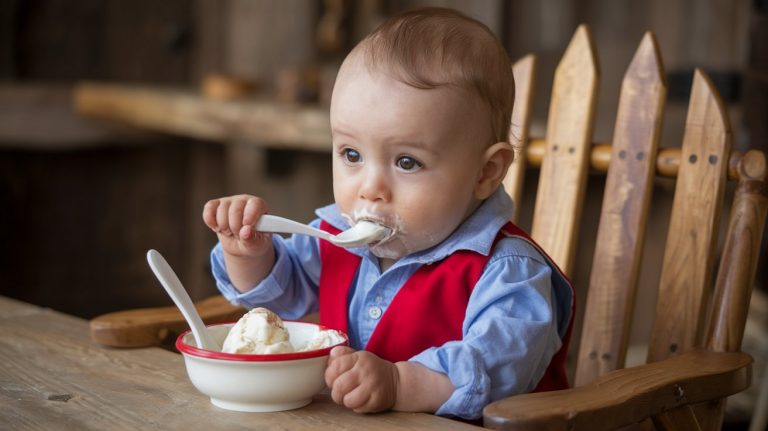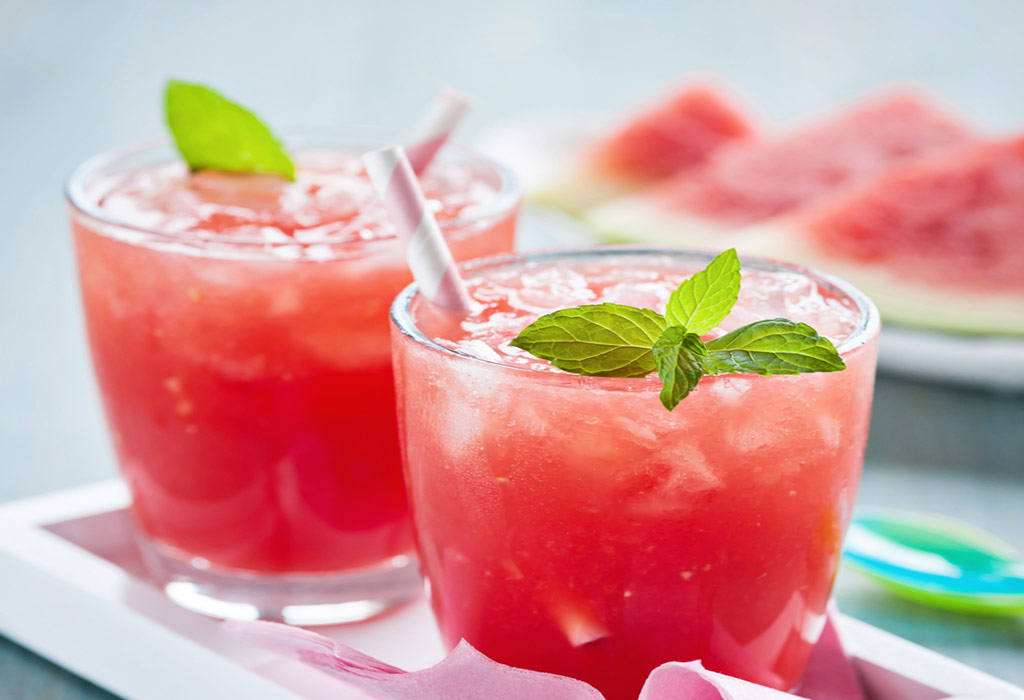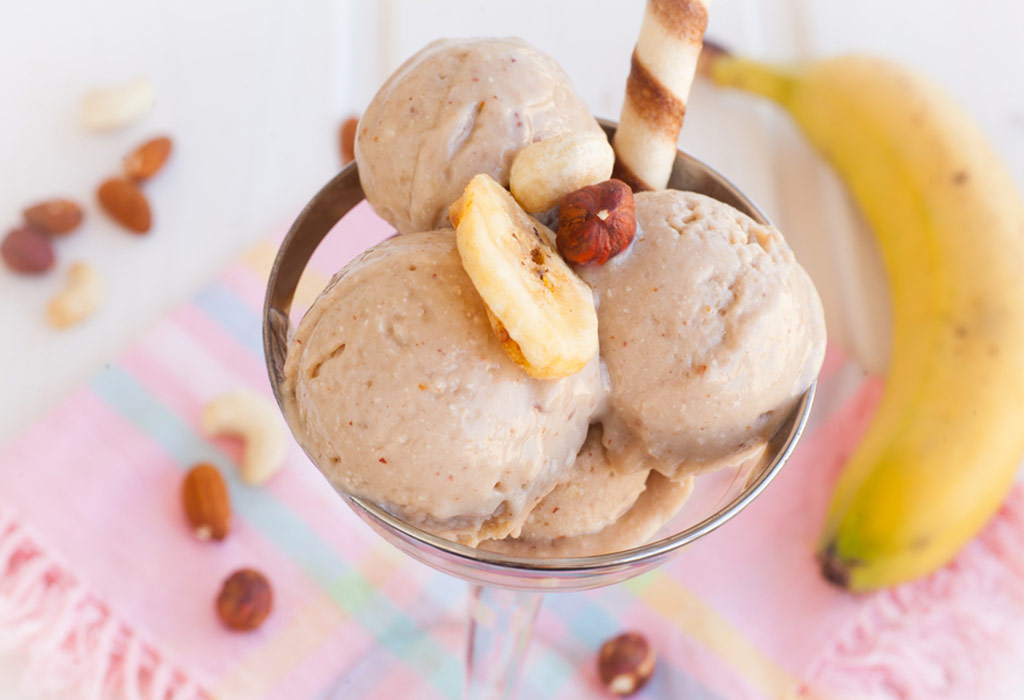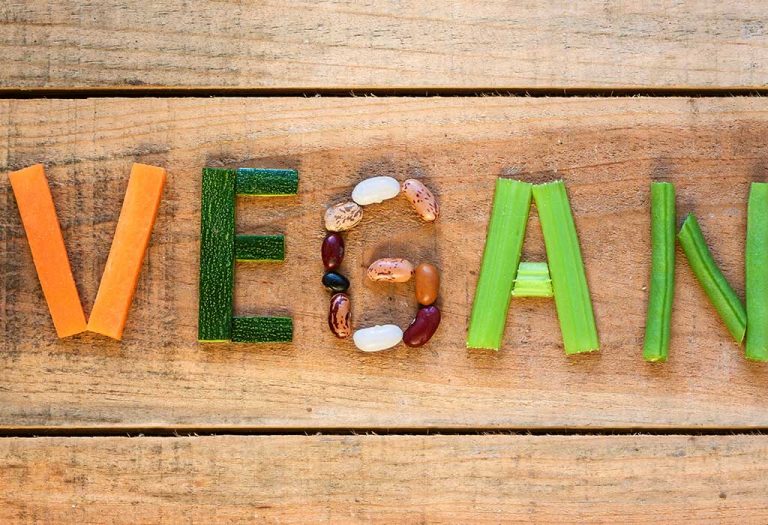Ice Cream for Babies – When and How to Introduce

Everybody finds it difficult to recall the first time they had an ice cream. But everybody rarely forgets the time when they see a baby taste ice cream for the very first time. It’s an exciting experience for babies, too, since they are exposed to different tastes, flavours and temperatures of food items for the first time in their lives. However, there’s always a suitable time and way to let your baby taste ice cream first. But before that, “Can infants have ice cream?” If your little one always gets impatient when they see you have ice cream, learning about whether it is safe to give babies ice cream and the best time and way to introduce ice cream to babies can benefit you.
Can Babies Have Ice Cream?
From a prevailing common sense, everybody knows that processed ice cream mostly consists of whole milk, processed fat and cream, and sugar. Certain ice creams may have other additives and flavours, and food colours might even be added to them. Babies can be sensitive to the preservatives, milk proteins, and minerals present in the ice cream (1). Though giving your baby ice cream is not recommended, there is no direct harm in giving them a small taste or a treat once in a while. However, sugar can be addictive, so it is advised not to expose your infants to sugary items until they turn 1 year of age. Honey is also prohibited for babies under the age of one as they can get infant botulism due to bacteria present in honey (2).
When Can Your Baby Eat Ice Cream?
Knowing that there is no harm in giving ice cream to your baby, you may be wondering, ‘When can I feed my baby ice cream?’ Before introducing your baby to ice cream, it’s best to get your baby familiar with a variety of dairy products. During the first year of your baby’s growth, gradually introduce cheese, curd or paneer and gauge his response to it. This also ensures that your baby does not have any lactose-related allergies. Once his body gets used to digesting dairy products, you can then introduce him to the beautiful taste of an ice cream.
Best Ways to Serve Ice Cream to Infants
Every baby develops taste buds at their own pace. The suggestions on how to prepare and feed particular foods may vary from child to child and are basically generalisations for a broader audience. It is thus advised to consult a doctor before if you are doubtful, as they will assess your baby’s health personally and guide you better.
12 Months
Once your baby is introduced to cow’s milk and other common allergens present in the ice cream, it can be safely introduced. You can begin by serving your child ice cream in a bowl so they can scoop it with a spoon or their hands. If they are able to thoroughly chew food, which is a little bit more challenging for those around 12 months of age, you can introduce a waffle cone. Please do not serve ice cream to your child that is unpasteurized, contains raw or undercooked eggs, or has choking hazards like nuts or candy.
24 Months
By this age, toddlers are well-versed in scooping and chewing thoroughly. So, you can safely give them waffle cones. Wait for your child to develop at least a set of molar teeth so they can learn to follow your directions and chew challenging foods like candies, pieces of nuts, chocolate chips, and jelly bits.
Tips for Introducing Ice Cream to Babies
Here are a few tips to consider before giving your baby ice cream for the first time.
1. Check Ingredients
Avoid ice creams with nuts or other items in them since your baby might be allergic to them, and you have yet to discover this for yourself. Also, avoid ice creams made with raw or unpasteurised milk as they may carry E. coli bacteria, which can be detrimental for babies (3). It is best to give children non-sugar or low-sugar foods, including ice cream. Reducing the sugar intake in children’s beginning years help them develop less preference of sugary items later (4).
2. Well-Known Brands
Do not get ice creams from street vendors or ice cream carts. Purchase them from a proper shop and a well-known brand.
3. Small Portions
Give your baby small bites of the ice cream. Do not hand an entire cone or a plate of ice cream for him to gorge on. This could upset his stomach easily.
4. Vanilla is King
Prefer a plain vanilla-flavoured ice cream at first. Not only is it a classic flavour that is universally loved, but it is free of any food colouring or other additives that might be present in other flavours.
5. Picture Perfect
Keep your camera ready! The facial expression of your baby tasting ice cream for the first time is going to be priceless. Make sure you capture it in its full glory.
Why Should You Avoid Giving Ice Cream to Babies Below 1 Year?
There are certain drawbacks to giving babies ice cream before the age of one.
1. Digestive Strength
Prior to a year, the strength of the digestive system of the baby is not at a level that can easily digest the constituents of an ice cream.
2. Presence of Preservatives
All the ice creams found in the market contain some form of preservative. These are combined with processed fat, sugar, artificial sweetening agents, food colouring agents, and so on. Exposing your baby to all these factors at such an early stage is not good for his health (5).
3. Dairy Products
Certain infants could have sensitivity issues to dairy. Since all ice creams are essentially manufactured using dairy, it is best to avoid exposing your baby to whole milk until he starts responding to other dairy product items gradually. Once a year has passed, you can introduce ice cream (6).
4. Presence Of Bacteria
Ice cream is formed by an inherent chemical process. Therefore, there is a good chance of bacteria being present in it, whether it is ice cream from the store or ice cream prepared at home. For a baby whose immune system hasn’t developed to its peak efficiency in under a year, such bacteria could spell health issues. At times, it could create a medical emergency as well.
5. Digestion Issues
Ice cream is known to cause a buildup of gas and acts directly with the colic tissue. This could cause stomach aches and other pain inside the baby’s body, leading to indigestion and vomiting at times.
Alternatives to Ice Cream for Your Baby (After 1 Year of Age)
- Crushed frozen fruits are a great option. Apples, mangoes or ripe bananas can be kept in the freezer. They can then be directly blended in a frozen state.
- Smoothies are a healthy way to go in exposing your baby to the sweet flavour. Since smoothies don’t have to be strictly refrigerated, you can make fresh smoothies and give them to your child, even in winter. Avoid canned fruits in such cases.
- Before making your baby taste the cold ice cream, you can try your hand at frozen yoghurt and see his response to it.
Easy Baby Ice Cream Recipes for Infants
Here are some simple ice cream recipes for your little one
1. Homemade Vanilla Ice Cream
This is the classic and one of the most preferred ice cream recipes by parents to introduce their children to ice cream.
Ingredients Needed:
- Ripe banana
- Strawberries
- Hass avocado
- Coconut milk
- Vanilla extract
How to Make:
- Put all the ingredients in a mixer and blend them together to make a thick puree.
- Put the puree in a container and place it in the freezer for an hour.
- Take it out and stir the puree properly.
- Place it in the freezer again for an hour. Keep repeating the process until it has reached a good consistency and resembles an ice cream.
2. Banana Ice Cream
Bananas are super beneficial to babies, and they can perfectly take the form of a frozen treat. It’s nutrition and taste!
Ingredients Needed:
- Ripe, frozen banana
- Cocoa powder
How to Make:
- Put the frozen banana in a mixer, along with cocoa powder. Blend the mixture.
- Put the mixture in a container and place it in the freezer for an hour.
- Take it out and stir the puree properly.
- Place it in the freezer again for an hour. Keep repeating the process until it has reached a good consistency.
3. Frozen Yoghurt Ice Cream
Yoghurt is good for babies above the age of one. Do try this unique ice cream for babies and toddlers.
Ingredients Needed:
- Greek yoghurt
- Sugar
- Vanilla extract
How to Make:
- Take a bowl and mix together the yoghurt, sugar and vanilla extract. Mix it well, cover the bowl with a lid, and place it in the refrigerator.
- Transfer the entire chilled mixture to an ice cream maker. Freeze it again until it reaches a consistency resembling a soft serve.
- Pour this into a separate container and keep it covered.
3. Chocolate Ice Cream
Love for chocolate knows no bounds, and if you want to introduce your little one to the taste of chocolate excitedly, then you can fulfil two wishes with one recipe.
Ingredients Needed:
- Unsweetened cocoa powder
- Brown sugar
- Sugar
- Cream milk
- Cream
- Vanilla extract
How to Make:
- Take a bowl and mix the cocoa powder, brown sugar and normal sugar in it together. Add some milk to it and keep stirring the mixture a few minutes.
- Add cream, vanilla extract and salt to the mixture and stir it further.
- Pour the entire mixture into an ice cream maker and churn it for half an hour.
- Freeze the mixture until it resembles an ice cream consistency.
5. Breastmilk and Banana Ice Cream
Don’t let that extra breastmilk that you pumped today go to waste. Turn it into a delicious frozen treat!
Ingredients:
- 2oz. breast milk
- 1 sliced banana
- ½tsp vanilla extract (optional)
- ¼ – ½tsp cinnamon
How to Make:
- Chop the banana into small pieces and refrigerate it for about 2 hours.
- In a blender, add the frozen banana slices, vanilla extract (optional), and cinnamon.
- Blend it nicely and gradually add in breast milk. Blend everything once the mixture becomes airy and resembles a soft-serve ice cream.
- Serve it fresh or store it in the freezer and feed it in small batches. Avoid storing it in the refrigerator for more than two-three days.
FAQs
1. Is it safe to give babies ice pops?
Yes, you can give homemade fresh fruit, frozen ice pops or popsicles to your baby once they are nine months or older. However, ice popsicles are not advised for babies as they are too cold and could cause sensitivity and popsicle panniculitis.
2. Can babies have ice cubes?
Ice cubes can be a choking hazard for babies and threatening. They may cause popsicle panniculitis (7). Thus, infants should not be given ice cubes (8).
3. How do babies react to ice cream intolerance?
Ice cream intolerance may arise due to lactose intolerance. In such cases, your baby may have loose stools and experience bloating, stomach cramps, flatulence, and nausea (9). Thus, unpasteurised or raw milk ice cream for infants is not preferred.
Introducing your baby to ice cream is a prized moment in itself. And the way to keep it healthy and safe is by opting for homemade ice cream. It’s best to add some healthy constituents to the ice cream so that it becomes nutritious as the baby enjoys tasting it. Have patience and let your baby turn a year old until he tastes ice cream for the first time. And as he grows older, you can slowly increase the serving!
References/Resources:
1. Why Do Infants Need Baby Formula Instead of Cow’s Milk?; American Academy of Pediatrics; https://www.healthychildren.org/English/ages-stages/baby/formula-feeding/Pages/Why-Formula-Instead-of-Cows-Milk.aspx
2. Why Should Babies Not Have Honey?; Nemours KidsHealth; https://kidshealth.org/en/parents/honey-botulism.html
3. Raw Milk; CDC; https://www.cdc.gov/food-safety/foods/raw-milk.html
4. Sanchez-Siles. L, et al.; Less Sugar and More Whole Grains in Infant Cereals: A Sensory Acceptability Experiment With Infants and Their Parents; Frontiers in Nutrition; https://www.frontiersin.org/journals/nutrition/articles/10.3389/fnut.2022.855004/full; May 2022
5. Rohrig. B; Ice, Cream… and Chemistry; ACS; https://www.acs.org/education/chemmatters/past-issues/archive-2013-2014/ice-cream-chemistry.html; February 2014
6. Cow’s Milk Alternatives: Parent FAQs; American Academy of Pediatrics; https://www.healthychildren.org/English/healthy-living/nutrition/Pages/Milk-Allergy-Foods-and-Ingredients-to-Avoid.aspx
7. A to Z: Panniculitis, Popsicle; CHOC; https://kidshealth.org/CHOC/en/parents/az-panniculitis.html
8. Choking Prevention for Children; Department of Health New York State; https://www.health.ny.gov/prevention/injury_prevention/choking_prevention_for_children.htm
9. 5 Can’t-Miss Signs That Your Child Is Lactose Intolerant; Cleveland Clinic; https://health.clevelandclinic.org/5-cant-miss-signs-child-lactose-intolerant
Also Read:
Giving Kiwi to Babies
Introducing Pineapple to Baby
Watermelon Benefits and Recipes for Babies
Introducing Avocado to Babies: When, Why & How
Was This Article Helpful?
Parenting is a huge responsibility, for you as a caregiver, but also for us as a parenting content platform. We understand that and take our responsibility of creating credible content seriously. FirstCry Parenting articles are written and published only after extensive research using factually sound references to deliver quality content that is accurate, validated by experts, and completely reliable. To understand how we go about creating content that is credible, read our editorial policy here.

























